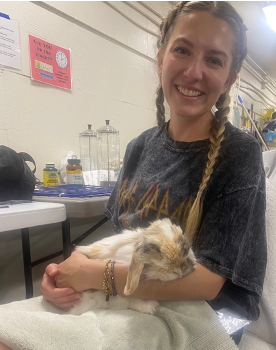🍀 Let's Talk Grooming!
- Admin Clover
- Aug 21
- 3 min read
🐰 Written By Our Hoppy Volunteer, Chelsea Coale Pangilinan
Do you know how often you should be grooming your rabbit? Let’s break it down. Many factors go into how often you should groom your rabbit. Your rabbit’s breed, hair type, texture, density, and if they are molting (which sometimes feels like always!).
🔍 What should you be checking when grooming?
Overall health of coat
Ears to make sure they look clean, healthy and free of wax build up
Eyes – wipe with warm compress if needed. For stubborn eye discharge you can use a Q-Tip with a little bit of Vaseline to help loosen the discharge. Be careful to not get it in eyes.
Feet for sore hocks
Scent glands – clean as needed with wet cotton round or Q-tip to prevent infection or impaction.
Trim nails every 4-6 weeks
Groom your rabbit in a quiet, peaceful space to help them feel safe. Place them gently on your lap and keep sessions short to reduce stress. Brush with soft, gentle strokes—avoid pulling or tugging, as their skin is extremely delicate.

Fur Types
Long haired breeds like Angoras, Lion Heads, Jersey Woolies, and American Fuzzy Lops need to be groomed daily to prevent mats and to maintain coat health.



Shorter haired rabbits like Holland Lops, Flemish Giants, and Dutch rabbits can be groomed weekly.



Molting
Rabbits typically molt twice a year – Spring and Fall. Although younger rabbits may molt more frequently as their adult coat comes in. Some breeds that have heavy seasonal molts: Netherlands, Mini Rexes and Cashmere Lops.
How can you tell when your rabbit is molting?
🔍 Some key indicators:
There is loose fur everywhere. You might find clumps of fur around their enclosure, on your clothes or floating in the air.
You’ll notice tufts of fur coming off easily with a gentle tug. Especially on the back and cheeks.
Their coat may look patchy and uneven.
When you pet them a fur storm happens – fur explodes into the air or sticks to your hand.
They may have a change in coat texture or color. New fur may grow back darker, lighter or softer. This is especially noticeable in breeds with multiple colors.
Rabbits often groom themselves more during shedding seasons, which can lead to excessive hair ingestion and increase the risk of GI stasis. Regular grooming helps prevent this and keeps your rabbit healthy.
Additional ways you can support your rabbit during their molt:
Increase fiber intake:
Offer unlimited hay – timothy (especially first and second cutting) and orchard are best. The fiber in the hay helps keep their GI tract moving and helps push out any ingested hair.
Add extra fiber greens like cilantro, dandelion or romaine.
High sugar fruits or treats should be avoided during molting.
Make sure your rabbit is staying hydrated. Offer fresh water in a bowl. Clean the bowl daily to avoid any hair in the water.
Soak veggies in the water for added hydration.
Give digestive or papaya supplements specifically made for rabbits. This will help break down the hair. (Please consult with your veterinarian first before giving any supplements).
Ensure your rabbit gets daily exercise—regular movement supports healthy digestion and overall well-being.
During molting it’s important to keep an eye out for GI stasis or blockages.
🔍 Things to look for:
Smaller or oddly shaped poops
Poops strung together with fur
Sitting hunched over or not moving much
Lack of appetite
No poop for 8-12+ hours
Bloating or hard belly
If your rabbit shows any of these signs seek medical attention immediately.
🪮 Grooming Tools [click on image to purchase on Amazon]
Below are different grooming tools we recommend:
For Angoras: A soft-bristled toothbrush is ideal for gently grooming the face and delicate areas around the eyes. We like this type of brush as it effectively brushes without any tugging.
.png)





